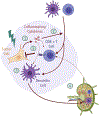Optimizing Radiation Therapy to Boost Systemic Immune Responses in Breast Cancer: A Critical Review for Breast Radiation Oncologists
- PMID: 32417409
- PMCID: PMC7646202
- DOI: 10.1016/j.ijrobp.2020.05.011
Optimizing Radiation Therapy to Boost Systemic Immune Responses in Breast Cancer: A Critical Review for Breast Radiation Oncologists
Abstract
Immunotherapy using immune checkpoint blockade has revolutionized the treatment of many types of cancer. Radiation therapy (RT)-particularly when delivered at high doses using newer techniques-may be capable of generating systemic antitumor effects when combined with immunotherapy in breast cancer. These systemic effects might be due to the local immune-priming effects of RT resulting in the expansion and circulation of effector immune cells to distant sites. Although this concept merits further exploration, several challenges need to be overcome. One is an understanding of how the heterogeneity of breast cancers may relate to tumor immunogenicity. Another concerns the need to develop knowledge and expertise in delivery, sequencing, and timing of RT with immunotherapy. Clinical trials addressing these issues are under way. We here review and discuss the particular opportunities and issues regarding this topic, including the design of informative clinical and translational studies.
Published by Elsevier Inc.
Figures




References
-
- Horton JK, Jagsi R, Woodward WA, et al. Breast cancer biology: Clinical implications for breast radiation therapy. Int J Radiat Oncol Biol Phys 2018;100:23–37. - PubMed
-
- Patnaik A, Kang SP, Rasco D, et al. Phase I study of pembrolizumab (MK-3475; anti-PD-1 monoclonal antibody) in patients with advanced solid tumors. Clin Cancer Res 2015;21:4286–4293. - PubMed
Publication types
MeSH terms
Grants and funding
LinkOut - more resources
Full Text Sources
Medical

